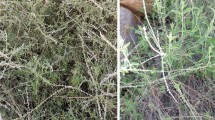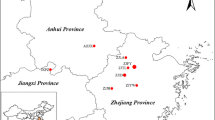Abstract
The genus Rosa is one of the most important genera of ornamental plants comprising of more than 120 species of which only eight were involved in the development of modern roses. Proper characterization and identification of the species require an accurate and reliable method that discriminates the different species. In the present study, 56 Simple Sequence Repeat (SSR) markers were used to identify and discriminate the 21 cultivated and four wild species of rose. Among the 56 SSR markers, 24 exhibited polymorphism giving a total of 47 alleles across the 28 rose species. The number of alleles ranged from 1 to 3 per marker locus with an average of 1.42. The polymorphism information content for 24 SSR markers ranged from 0.102 (Rw5G14) to 0.87 (Rw60A16) with an average of 0.365. Maximum dissimilarity was observed between R. tomentosa and R. slancensis with similarity coefficient of 0.33. In UPGMA based clustering, R. brunonii was placed along with R. dumalis and similarly R. tomentosa and R. damascena cv. Jwala were placed together, though, they were placed distinctly but on the same coordinates by the principal component analysis. The higher degree of similarity between R. brunonii and R. dumalis was supported by both molecular and morpholgical data while that of between R. macrophylla and R. hybrida cv. Rose Sherbet and wild species as shown in the present study could not be supported by the morphological data based on Distinctness, Uniformity and Stability descriptors. Hence, Simple Sequence Repeat markers proved useful in identifying and assessing genetic relationships among cultivated species of rose, whereas, wild species need more robust dataset with still higher number of markers.


Similar content being viewed by others
Data Availability
All datasets generated and analyzed in the current study are available in the supplementary file
Abbreviations
- RAPD:
-
Random amplified polymorphic DNA
- AFLP:
-
Amplified fragment length polymorphism
- ISSR:
-
Inter simple sequence repeat
- SSR:
-
Simple sequence repeats
- PIC:
-
Polymorphism information content
- PCA:
-
Principal component analysis
- MI:
-
Marker index
- Rp:
-
Resolving power
- DUS:
-
Distinctness, Uniformity and Stability
- NTSYS:
-
Numerical Taxonomy and Multivariate Analysis System
- UPGMA:
-
Unweighted pair-group method with arithmetic averages
- SAHN:
-
Sequential, agglomerative, hierarchical and nested clustering algorithm
References
Aparna V, Bhat KV, Janakiram T, Prasad KV, Raju DVS, Panwar S, Singh KP (2019) Assessment of genetic diversity and population structure of fragrant rose (Rosa × hybrida) cultivars using microsatellite markers. Indian J Agric Sci 89(11):1964–1970
Babaei A, Tabaei-Aghdaei R, Khosh-Khui M, Omidbaigi R, Naghavi M, Esselink GD, Smulders MJM (2007) Microsatellite analysis of Damask rose Rosa damascena Mill accessions from various regions in Iran reveals multiple genotypes. Plant Biol. https://doi.org/10.1186/1471-2229-7-12
Becher SA, Steinmetz K, Weising K, Boury S, Peltier D, Renou JP, Kahl G, Wolff K (2000) Microsatellites for cultivar identification in Pelargonium. Theor Appl Genet 101:643–651
Bruneau A, Starr JR, Joly S (2007) Phylogenetic relationships in the genus Rosa: new evidence from chloroplast DNA sequences and an appraisal of current knowledge. Syst Bot 322:366–378
Chesnokov YV, Artemyeva AM (2015) Evaluation of the measure of polymorphism information of genetic diversity. Selskokhoziaistvennaia Biol 50(5):571–578
Doyle JJ, Doyle JL (1990) Isolation of plant DNA from fresh tissue. Focus 12:13–15
Esselink GD, Smulders MJM, Vosman B (2003) Identification of cut-rose Rosa hybrida and rootstock varieties using robust sequence tagged microsatellite markers. Theor Appl Genet 106:277–286
Farooq A, Kiani M, Khan MA, Riaz A, Khan AA, Anderson N, Byrne DH (2013) Microsatellite analysis of Rosa damascena from Pakistan and Iran. Hort Environ Biotechnol 542:141–147
Gaurav AK, Namita Raju DVS, Singh M, Singh B, Krishnan SG, Mithra SV, Panwar S, Singh M, Dhiman MR (2018) Genetic characterization of Rosa species using morphological markers. Indian J Agric Sci 88(9):1396–1402
S Gudin (2000) Rose breeding technologies III International Symposium on Rose research and cultivation. 547: 23 33
Hibrand-Saint Oyant L, Crespel L, Rajapakse S, Zhang L, Foucher F (2008) Genetic linkage maps of rose constructed with new microsatellite markers and locating QTL controlling flowering traits. Tree Gen Genom 4:11–23
Jaccard P (1908) Nouvellesrecherchessur la distribution florale. Bull Soc Vaudoise Sci Nat 44:223–270
Kaul K, Karthigeyan S, Dhyani D, Kaur N, Sharma RK, Ahuja PS (2009) Morphological and molecular analyses of Rosa damascena× R. bourboniana interspecific hybrids. Sci Hort 1222:258–263
Kimura T, Nishitani C, Iketani H, Ban Y, Yamamoto T (2006) Development of microsatellite markers in rose. Mol Ecol Resour 63:810–812
Koopman WJ, Wissemann MV, De-Cock K, Van-Huylenbroeck J, De Riek J, Sabatino GJH, Visser D, Vosman B, Ritz CM, Maes B, Werlemark G, Nybom H, Debener T, Linde M, Smulders MJM (2008) AFLP markers as a tool to reconstruct complex relationships: a case study in Rosa Rosaceae. Amer J Bot 95:353–366
Ku TC, Robertson KR (2003) Rosa linnaeus. In: Wu CY, Raven PH (eds) Flor China vol 9, pp 339–381
Lewis WH (1957) Revision of the genus Rosa in eastern North America: a review. Am Rose Ann 42:116–126
Matsumoto SM, Kouchi HF, Ueda Y (2000) Phylogenetic analyses of the subgenus Eurosa using the ITS nrDNA sequence. Acta Hort 521:193–202
Nadeem M, Wang X, Akond M, Awan F, Riaz S, Younis A (2014) Hybrid identification morphological evaluation and genetic diversity analysis of’ Rosa × hybrida by SSR markers. Aust J Crop Sci 8(2):183
Nawaz T, Hameed MA, Ashraf MU, Al-Qurainy F, Ahmad MS, Younis AD, Hayat MU (2011) Ecological significance of diversity in leaf tissue architecture of some species/cultivars of the genus Rosa L. Pak J Bot 432:873–883
Olsson A, Nybom H, Prentice HC (2000) Relationships between Nordic dog roses Rosa L. sect. Caninae Rosaceae assessed by RAPDs and elliptic fourier analysis of leaflet shape. Syst Bot 25:511–521
Panwar S, Singh KP, Namita Sonah H, Deshmukh RK, Sharma TR (2015a) Identification and characterization of microsatellites in ESTs of Rosa species: insightin development of SSR markers. Indian J Agric Sci 85(3):429–433
Panwar S, Singh Kanwar P, Sonah H, Deshmukh R, Namita, Prasad KV, Sharma TR (2015b) Molecular fingerprinting and assessment of genetic diversity in rose (Rosa ×hybrida). Indian J Biotech 14(4):518–524
Rai H, Raju DVS, Arun Kumar MB, Janakiram T, Gopala Krishnan S, Namita, Rana JC (2015) Characterization and analysis of genetic diversity among differentspecies of rose (Rosa species) using morphological and molecular markers. Indian J Agric Sci 85(2):240–245
Rathore DS, Shrivastava C (1992) Rosa species (A bulletin). National Bureau of Plant Genetic Resources; Regional station, Phagli, Shimla India
Rehder A (1940) Manual of cultivated trees and shrubs. The Macmillan Company; New York, USA
Revelle W (2017) psych: procedures for personality and psychological research, Northwestern University, Evanston, Illinois, USA, Version = 1.7.8
Rohlf F J (1998) NTSyS-p.c. Numerical taxonomy and multivariate analysis system (Version 2.0). Exeter Software Publishers Ltd. Setauket
Samiei L, Naderi R, Khalighi A, Bushehri A, Mozaffarian V, Esselink GD, Smulders MJM (2009) In search of genetic diversity in Rosa foetida Herrmann in Iran. Acta Hort 836:25–30
Scariot V, Akkak A, Botta R (2006) Characterization and genetic relationships of wild species and old garden roses based on microsatellite analysis. J Amer Soc Hort Sci 131:66–73
Shingote Prashant R et al. (2019) LTR retrotransposons and highly informative ISSRs in combination are potential markers for genetic fidelity testing of tissue culture-raised plants in sugarcane. Mol breed 39(2):25
Singh S, Dhyani D, Nag A, Sharma RK (2017) Morphological and molecular characterization revealed high species level diversity among cultivated introduced and wild roses (Rosa sp.) of western Himalayan region. Gen Resour Crop Evol 643:515–530
Smulders MJM, Esselink D, Voorrips RE, Vosman B (2009) Analysis of a database of DNA profiles of 734 hybrid tea rose varieties. Acta Hort 836:169–174
Tribhuvan KU, Amitha Mithra SV, Sharma P, Das A, Kumar K, Tyagia A, Solanke AKU, SharmaSandhya R, Jadhav PV, Raveendran M, Fakrudin B, Sharma TR, Singh NK Gaikwad K (2019) Identification of genomic SSRs in cluster bean (Cyamopsis tetragonoloba) and demonstration of their utility in genetic diversity analysis. Ind Crop Prod 133:221–231
Wissemann V (2000) Epicuticular wax morphology and the taxonomy of Rosa section Caninae subsection Rubiginosae. Plant Syst Evol 221:107–112
Wissemann V (2003) Conventional taxonomy of wild roses. In: Debener Roberts A, T and Gudin S, (eds) Encyclopedia of rose science. Academic Press, London
Wu S, Ueda Y, He H, Nishihara S, Matsumoto S (2000) Phylogenetic analysis of Japanese Rosa species using matK sequences. Breed Sci 504:275–281
Wu S, Nishihara S, Ueda Y (2001) Phylogenetic analysis of section Synstylaein the genus Rosa based on RAPD markers. Acta Hort 547:391–402
Yu TT, Lu LT, Ku TC, Kuan KC, Li CL (1985) Rosaceae 2. Flora Rei 37:1–516
Zhang LH, Byrne DH, Ballard RE, Rajapakse S (2006) Microsatellite marker development in rose and its application in tetraploid mapping. J Am Soc Hortic Sci 131(3):380–387
Acknowledgement
Financial support (BT/PR7248/PBD/16/1019/2013) by Department of Biotechnology, Ministry of Science and Technology, Government of India, New Delhi for conducting research is highly acknowledged. The first author acknowledges the University Grant Commission (UGC), Govt. of India, New Delhi for providing National Fellowship-OBC during his doctoral programme. Authors acknowledge the ICAR-NBPGR for providing the cuttings of Rosa species for research purpose.
Funding
The funding obtained from the Department of Biotechnology, Ministry of Science and Technology, Government of India, New Delhi, India through Grant Number (BT/PR7248/PBD/16/1019/2013) is greatly acknowledged.
Author information
Authors and Affiliations
Contributions
The work was conceived and designed by AMS, N and DVSR. Sampling was done by AKG, N, MKS and SP. DNA isolation and SSR genotyping were standardized and completed by AKG, N, DVSR, and MKR. Molecular data analysis was guided by BS, SGK and AMS and carried out by AKG and N. The first draft was written by AKG and N. Critically reviewed the manuscript: SGK and AMS. DVSR and AMS finalized the manuscript and all the authors read it and approved the same.
Corresponding author
Ethics declarations
Conflict of interest
The authors declare that they have no conflict of interest
Additional information
Publisher's Note
Springer Nature remains neutral with regard to jurisdictional claims in published maps and institutional affiliations.
Supplementary Information
Rights and permissions
About this article
Cite this article
Gaurav, A.K., Namita, Raju, D.V.S. et al. Genetic diversity analysis of wild and cultivated Rosa species of India using microsatellite markers and their comparison with morphology based diversity. J. Plant Biochem. Biotechnol. 31, 61–70 (2022). https://doi.org/10.1007/s13562-021-00655-3
Received:
Accepted:
Published:
Issue Date:
DOI: https://doi.org/10.1007/s13562-021-00655-3




